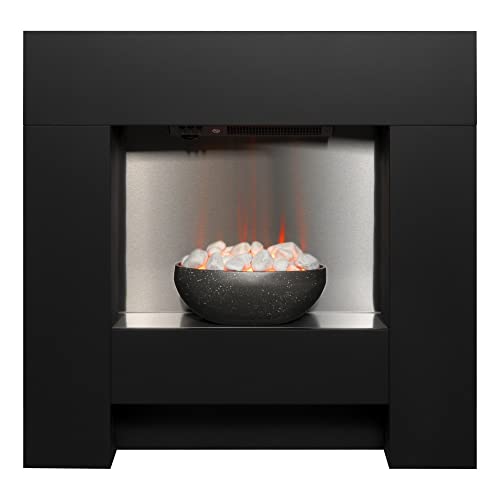A Comprehensive Guide to Small Fireplaces: Efficient Heating and Cozy Living
In a period where energy effectiveness and space optimization are ending up being progressively essential, small fireplaces have emerged as an appealing option to traditional, large hearths. These compact heating options provide heat and a centerpiece for any room, heightening both comfort and visual appeal. This post explores the various kinds of small fireplaces, their advantages, setup factors to consider, and upkeep ideas, eventually helping house owners make informed choices when considering these lovely heating choices.
Understanding Small Fireplaces
Small fireplaces use a range of styles, consisting of electric, gas, ethanol, and wood-burning models. Fireplaces And Stoves provides special benefits and design possibilities, making them ideal for numerous living spaces.
Kinds Of Small Fireplaces
| Fireplace Type | Description | Pros | Cons |
|---|---|---|---|
| Electric | Uses electrical power to produce heat. Provides numerous styles, including wall-mounted and freestanding units. | - Easy to set up - Low upkeep - No venting required | - Limited heat output - May incur higher electrical energy costs |
| Gas | Burns gas or propane. Often offered as logs in a traditional fireplace or modern styles. | - Efficient heat output - Cleaner than wood - Easy ignition | - Requires gas line setup - Some systems require venting |
| Ethanol | Burns bioethanol, supplying real flames without a chimney. | - Eco-friendly - Portable - No installation needed | - Limited heat output - Higher fuel expenses |
| Wood-Burning | Traditional fireplaces that burn fire wood. Often used in more rustic settings. | - Great heat output - Rich ambiance - Can be used throughout power interruptions | - Requires a chimney - Regular maintenance and cleansing |
Advantages of Small Fireplaces
- Space Efficiency: Small fireplaces are perfect for apartments, condos, and smaller sized homes. They take full advantage of heat without taking up extreme flooring area.
- Cost-Effective Heating: In particular cases, small fireplaces can supplement main heating unit, decreasing general energy expenses while creating a more comfy environment.
- Atmosphere and Aesthetics: They supply a welcoming centerpiece to a space, producing a cozy atmosphere perfect for relaxation and celebrations.
- Adaptability: Available in different styles and styles, small fireplaces can complement any decor, from modern minimalist to rustic traditional.
Setup Considerations
When pondering a small fireplace, setup is an essential aspect that can impact the option of model. Below are handy factors to consider:
- Local Regulations: Building codes can vary by location; constantly check local guidelines before installation.
- Ventilation Needs: Depending on the type, small fireplaces may require different ventilation systems. Gas fireplaces might require venting outdoors, while electric models don't.
- Power Source: Electric models require distance to electric outlets, while gas and ethanol designs might require a gas line or fuel storage.
- Weight and Structure: Installing wall-mounted systems might need strengthened wall areas, whereas free-standing models are much easier to transfer.
Upkeep Tips
Like any other home appliance, small fireplaces need regular upkeep to operate efficiently and securely. Here are essential upkeep suggestions for various fireplace types:
For Electric Fireplaces:
- Cleaning: Wipe down the system with a soft cloth to get rid of dust and keep the heating system ducts clear.
- Inspection: Check the power cable frequently for any damages or indications of wear.
For Gas Fireplaces:
- Annual Inspections: Schedule annual examinations by an expert to guarantee safe gas circulation.
- Clean the Logs: Regularly clean the burner and logs to keep ideal efficiency.
For Ethanol Fireplaces:
- Fuel Storage: Store ethanol fuel safely far from direct sunshine and heat sources.
- Routine Cleaning: Clean the burner after each usage to keep effectiveness and avoid soot accumulation.
For Wood-Burning Fireplaces:
- Chimney Sweeping: Have the chimney expertly cleaned up once a year to avoid creosote accumulation.
- Firewood Storage: Only usage dry, experienced wood to minimize smoke and promote effective burning.
Often Asked Questions
1. Can I set up a small fireplace myself?
While some electric and ethanol fireplaces are reasonably easy to install, it is advisable to employ a professional for gas and wood-burning systems to guarantee compliance with local building regulations.
2. How much does it cost to run a small fireplace?
The cost will vary depending on the type of fireplace. Normally, electric fireplaces might incur higher electrical power costs, while wood-burning options can draw from sustainable firewood supplies.
3. Do I need an authorization for setup?
Permits are typically required for gas and wood-burning fireplaces due to their setup intricacy and safety policies. Always consult regional authorities.
4. For how long can I run an electric fireplace?
Most electric fireplaces can run for extended periods; however, it's advised to follow maker guidelines to avoid getting too hot or damaging the system.
5. What kind of small fireplace is best for a small space?
This mostly depends upon individual requirements. Electric designs are flexible and easy to set up, while gas and ethanol choices supply real flames with effective heat output.
Small fireplaces represent a functional and trendy option for those seeking efficient heating solutions in compact home. With different types offered, property owners can pick models that line up with their aesthetic choices and space requirements. By understanding the setup procedures and routine upkeep needed, individuals can enjoy the comfort and atmosphere that small fireplaces provide for several years to come. Whether for a cozy night at home or a welcoming space for events, small fireplaces are an enduring element of modern and traditional decoration alike.

